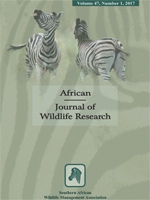African lions (Panthera leo) are threatened across their natural range. However, the Kgalagadi Transfrontier Park (KTP) is a stronghold for the species. A population assessment in 2010 observed a skew in the sex structure with a greater proportion of males (56%) which raised concerns about the long-term sustainability of the greater KTP lion population. A key indicator of how a population responds to changes in population structure is population size. We conducted an intensive lion census between 2013 and 2015 in the southwestern KTP (14 250 km2) driving 49 784 km over 317 sampling days, which resulted in 1162 lion sightings. Registering the population through individual identification (n = 261) provided a benchmark against which other techniques could be measured and for a non-invasive marking technique. Open-population mark-recapture provided the most precise estimate of population size (n = 246; 95%CI: 237–256). Track indices (n = 242; 95%CI: 176–307) provided a similar best estimate, but were imprecise. Minimum-known-alive calculations (n = 145) provided a gross underestimate. All the methods used in this study indicate a larger lion population size than previous estimates.
How to translate text using browser tools
1 April 2017
Estimating African Lion Abundance in the Southwestern Kgalagadi Transfrontier Park
B. Otto Beukes,
Frans G.T. Radloff,
Sam M. Ferreira
ACCESS THE FULL ARTICLE
African lion
individual identification
Kgalagadi Transfrontier Park
mark-recapture
minimum-known-alive
Panthera leo
registration





